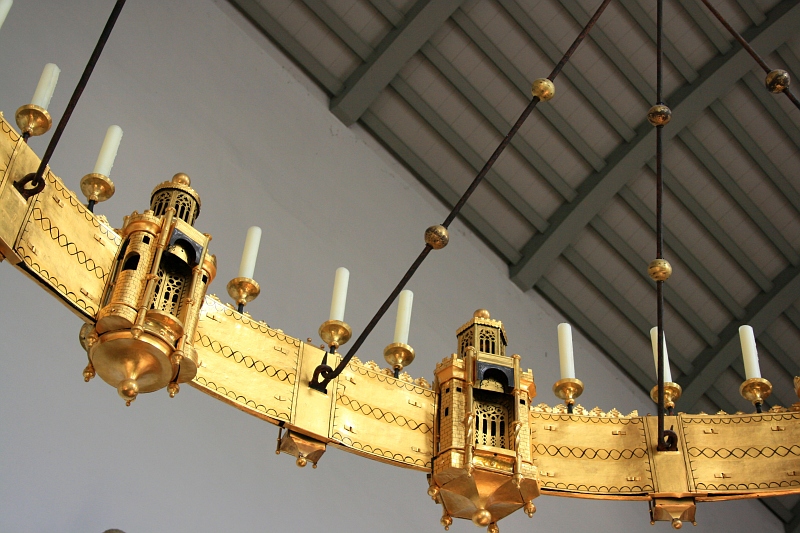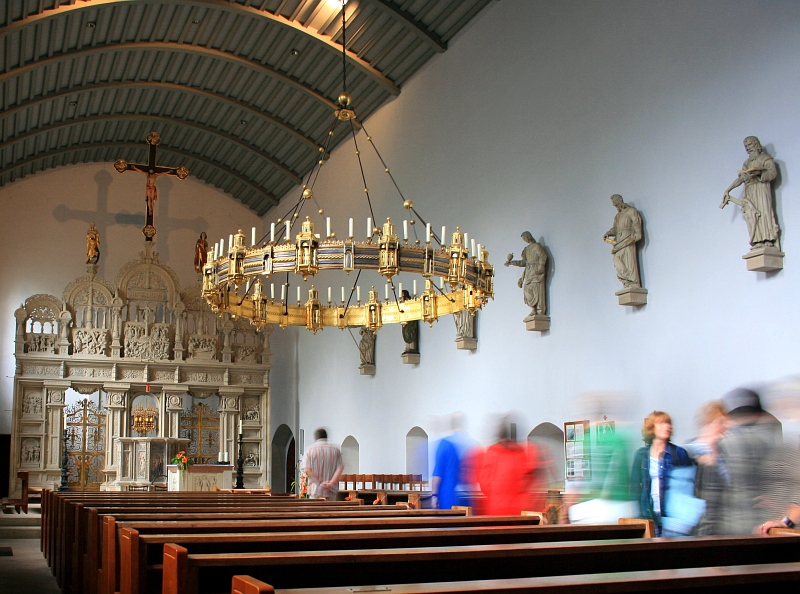Azelin chandelier on:
[Wikipedia]
[Google]
[Amazon]
The Azelin chandelier (german: Azelinleuchter) is a Romanesque
 A wheel chandelier is also called a ' (crown) and circular chandelier.Julia de Wolf Addison
A wheel chandelier is also called a ' (crown) and circular chandelier.Julia de Wolf Addison
Arts and Crafts in the Middle Ages
Medieval Histories Like the later and larger Hezilo chandelier, the Azelin chandelier is a circular hoop of gilt copper and
 The Azelin chandelier, named for its supposed donor, the bishop
The Azelin chandelier, named for its supposed donor, the bishop
Weltkulturerbe in Niedersachsen. Retrieved 9 May 2014 It is not clear, in that case, how the chandelier survived the fire of 1046. From 1960, when the cathedral and the adjacent buildings were rebuilt, the chandelier hung in the church of St. Antonius, adjacent to the
(German) (PDF; 2,9 MB). Retrieved 18 January 2012 *
wheel chandelier
A wheel chandelier is a lighting installment, in the form of a chandelier hanging from the ceiling in the form of a spoked wheel. The oldest and most important examples derive from the Romanesque period.
Wheel chandeliers were made for the prac ...
, made in the 11th century for the Hildesheim Cathedral
Hildesheim Cathedral (German: '), officially the Cathedral of the Assumption of Mary (German: ''Hohe Domkirche St. Mariä Himmelfahrt'') or simply St. Mary's Cathedral (German: ''Mariendom''), is a medieval Roman Catholic cathedral in the city cent ...
in Hildesheim
Hildesheim (; nds, Hilmessen, Hilmssen; la, Hildesia) is a city in Lower Saxony, Germany with 101,693 inhabitants. It is in the district of Hildesheim, about southeast of Hanover on the banks of the Innerste River, a small tributary of the Lei ...
, Germany, a UNESCO World Cultural Heritage
A World Heritage Site is a landmark or area with legal protection by an international convention administered by the United Nations Educational, Scientific and Cultural Organization (UNESCO). World Heritage Sites are designated by UNESCO for h ...
site since 1985. It is the oldest of four extant wheel chandeliers from that period, along with the Hezilo chandelier
The Hezilo chandelier (german: Heziloleuchter) is an 11th-century Romanesque wheel chandelier. It is part of the treasures of the Hildesheim Cathedral in Hildesheim, Germany, which has been a UNESCO World Cultural Heritage site since 1985. The cha ...
, also in Hildesheim, the Barbarossa chandelier in the Aachen Cathedral
Aachen Cathedral (german: Aachener Dom) is a Roman Catholic church in Aachen, Germany and the seat of the Roman Catholic Diocese of Aachen.
One of the oldest cathedrals in Europe, it was constructed by order of Emperor Charlemagne, who was buri ...
, and the Hartwig chandelier in the Abbey of Comburg. It was believed to be donated by Bishop
A bishop is an ordained clergy member who is entrusted with a position of authority and oversight in a religious institution.
In Christianity, bishops are normally responsible for the governance of dioceses. The role or office of bishop is ca ...
Azelin
Azelin (before 1000 – 8 March 1054) was Bishop of Hildesheim from 1044 until 1054.
Azelin's origin is not known. He was appointed Bishop of Hildesheim by Emperor Henry III, succeeding Thietmar. During his tenure, the cathedral built by Altfr ...
, however his predecessor Thietmar is more likely to be the patron. Therefore, the chandelier is also called the Thietmar chandelier (''Thietmarleuchter'').
Description
 A wheel chandelier is also called a ' (crown) and circular chandelier.Julia de Wolf Addison
A wheel chandelier is also called a ' (crown) and circular chandelier.Julia de Wolf AddisonArts and Crafts in the Middle Ages
Medieval Histories Like the later and larger Hezilo chandelier, the Azelin chandelier is a circular hoop of gilt copper and
tinplate
Tinplate consists of sheets of steel coated with a thin layer of tin to impede rusting. Before the advent of cheap milled steel, the backing metal was wrought iron. While once more widely used, the primary use of tinplate now is the manufacture of ...
, decorated with twelve towers and twelve gatehouses. However, the decoration is much sparser, limited to a braid
A braid (also referred to as a plait) is a complex structure or pattern formed by interlacing two or more strands of flexible material such as textile yarns, wire, or hair.
The simplest and most common version is a flat, solid, three-strande ...
ed bar in the middle of the hoop and an openwork
Openwork or open-work is a term in art history, architecture and related fields for any technique that produces decoration by creating holes, piercings, or gaps that go right through a solid material such as metal, wood, stone, pottery, cloth, l ...
wreath of foliage on the upper edge of the hoop. The twelve gatehouses, to which the ropes holding the chandelier up are attached, are basically rectangular in shape with rounded arches and roofing. It is possible that they once held figures, but these would have had to have been very small and flat. The twelve towers are more elaborate, with a hexagonal groundplan. On the outside there are three niches closed with openwork doors, on the inside there is one niche flanked by two (alternately round or square) towers decorated with battlements and imitation brickwork. The spires of the towers extend above the top of the chandelier's hoop and are alternately round or hexagonal, with openwork windows in imitation of roof lantern
A roof lantern is a daylighting architectural element. Architectural lanterns are part of a larger roof and provide natural light into the space or room below. In contemporary use it is an architectural skylight structure.
A lantern roof wil ...
s.
The Azelin chandelier has been repeatedly altered by additions, removals, and repairs over the centuries. The overall image of the New Jerusalem
In the Book of Ezekiel in the Hebrew Bible, New Jerusalem (, ''YHWH šāmmā'', YHWH sthere") is Ezekiel's prophetic vision of a city centered on the rebuilt Holy Temple, the Third Temple, to be established in Jerusalem, which would be the c ...
, lit up and floating in the air, which all works of this type present, has been maintained. An important and meticulous restoration of the chandelier was carried out between 1982 and 1989, repairing damage of World War II.
History
 The Azelin chandelier, named for its supposed donor, the bishop
The Azelin chandelier, named for its supposed donor, the bishop Azelin
Azelin (before 1000 – 8 March 1054) was Bishop of Hildesheim from 1044 until 1054.
Azelin's origin is not known. He was appointed Bishop of Hildesheim by Emperor Henry III, succeeding Thietmar. During his tenure, the cathedral built by Altfr ...
(1044–1054) is the predecessor of the Hezilo chandelier, which was probably commissioned by Azelin's successor Hezilo. Perhaps the two wheel chandeliers were originally planned as a set, just as they then hung in the cathedral for centuries: the Hezilo chandelier in the nave, the Azelin chandelier (which is about half the size) in the choir
A choir ( ; also known as a chorale or chorus) is a musical ensemble of singers. Choral music, in turn, is the music written specifically for such an ensemble to perform. Choirs may perform music from the classical music repertoire, which ...
. The chandeliers were created after the devastating fire of 1046, in which the cathedral of Altfrid
Saint Altfrid (or Altfrid of Hildesheim) (died 15 August 874) was a leading figure in Germany in the ninth century. A Benedictine monk, he became Bishop of Hildesheim, and founded Essen Abbey. He was also a close royal adviser to the East Frankis ...
and many nearby buildings in the Domhof were destroyed. Before this, a gold and silver wheel chandelier, gifted by Bernward of Hildesheim
Bernward (c. 960 – 20 November 1022) was the thirteenth Bishop of Hildesheim from 993 until his death in 1022.
Life
Bernward came from a Saxon noble family. His grandfather was Athelbero, Count Palatine of Saxony. Having lost his parents at ...
had hung in the nave. This earlier chandelier was definitely destroyed in the fire.Victor H. Elbern, ''Dom und Domschatz in Hildesheim'', Königstein 1979, p. 12. The chandelier was thought to have been commissioned by Bishop Azelin after this fire, but according to a lost document from the 16th century his predecessor Thietmar of Hildesheim was the patron.Der ThietmarleuchterWeltkulturerbe in Niedersachsen. Retrieved 9 May 2014 It is not clear, in that case, how the chandelier survived the fire of 1046. From 1960, when the cathedral and the adjacent buildings were rebuilt, the chandelier hung in the church of St. Antonius, adjacent to the
cloisters
A cloister (from Latin ''claustrum'', "enclosure") is a covered walk, open gallery, or open arcade running along the walls of buildings and forming a quadrangle or garth. The attachment of a cloister to a cathedral or church, commonly against a ...
of the cathedral. After the completion of extensive restorations of the cathedral, reopened on 15 August 2014, and the conversion of St. Antonius to a part of the Cathedral museum, the Azelin chandelier was returned to the cathedral and placed again above the altar in the crossing, while the Hezilo chandelier, which hung there before, was returned to its original location in the nave.
Literature
* Bernhard Gallistl: ''Bedeutung und Gebrauch der großen Lichterkrone im Hildesheimer Dom''. In: ''Concilium medii aevi 12'', 2009, S. 43–88, online(German) (PDF; 2,9 MB). Retrieved 18 January 2012 *
Adolf Bertram
Adolf Bertram (14 March 1859 – 6 July 1945) was archbishop of Breslau (now Wrocław, Poland) and a cardinal of the Roman Catholic Church.
Early life
Adolf Bertram was born in Hildesheim, Royal Prussian Province of Hanover (now Lower Saxony), ...
, ''Geschichte des Bisthums Hildesheim'', (German) vol. 1, Hildesheim 1899, p. 106.
* Christine Wulf: ''Die Inschriften der Stadt Hildesheim.'' (German) Wiesbaden 2003 (''Die deutschen Inschriften 58''). vol. 2. pp. 213–216.
References
{{reflist Romanesque art Individual lamps Hildesheim Cathedral Medieval European metalwork objects